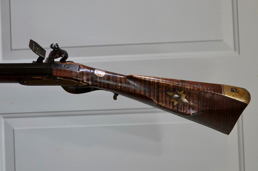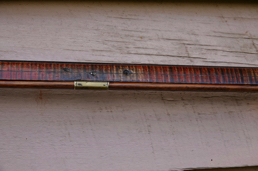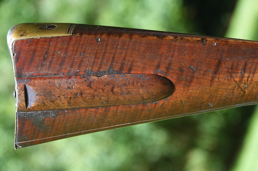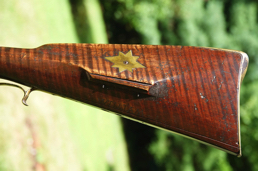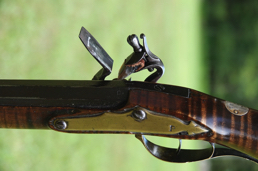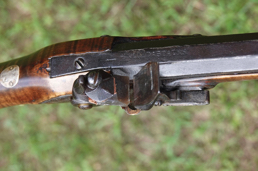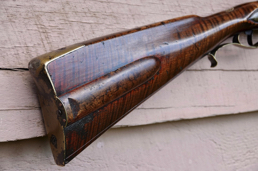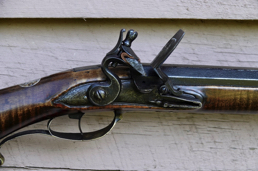Riffle for the County of Northumberland, 1778
In September of 1777, during the early stages of the American Revolution, the British occupied Philadelphia. Many important activities orchestrated by the Committee of Congress as well as the Executive Council for Pennsylvania were hastily withdrawn in a mad rush to clear the city prior to the British occupation, and important armories necessary for the construction and maintenance of American arms were removed and established out of the reach of the occupiers. One such important armory was established in Northampton County at Allentown between October, 1777 and January, 1779 under the supervision of Ebenezer Cowell and John Tyler. A number of men, virtually all of whom remain unknown, were called into service to maintain State arms that were funneled up to Allentown as well as to additional Northampton County operations at Bethlehem and Easton. Northampton County, previously viewed as somewhat of an upcountry ‘backwater’ became - for this roughly two year period - one of the busiest locales in the state.
On May 16, 1778, a directive was issued by the Pennsylvania Supreme Executive Council (at that time meeting in Lancaster) and sent to the overseers of the Allentown armories:
"From the situation of the Western frontiers, it appears to be necessary to supply the County of Northumberland with Arms, and there being Thirty-One Riffles in the hands of John Butler, one of the Armourers, Ordered, That John Tyler, Armourer, do send a Waggon load of Arms in repair, to Col. Jacob Morgan, Lieutenant of the County of Berks, among which the Thirty-one Riffles are to be a part, & packed separate from the rest, & to be by Col. Morgan forwarded to Sam'l Hunter, Esq., Lieu. of the County of Northumberland, for the use of the Militia." (Colonial Records XI, 490)
This rifle is believed to be the only surviving example of a Revolutionary War-era rifle that appears to not only have been constructed in Northampton County (quite possibly Allentown itself) but also to have passed through the armory and marked as property of both Pennsylvania as well as the United States. Furthermore, because the piece has long been owned by an old family of Sunbury, it is currently thought that it may be one of the “Riffles” specifically mentioned as being destined for the Northumberland County militia in the notice of May, 1778.
The Northumberland militia, under the general oversight of Lieutenant (later Colonel) Samuel Hunter at Fort Augusta (part of present-day Sunbury, PA), was a true “frontier” militia, responsible for an immense area from Fort Augusta northeast and northwest along both branches of the Susquehanna river. From the summer of 1777 through the end of the Revolution, the militia was constantly engaged with British-allied natives engaged in raids down both branches of the river; all the while, the Northumberland militia was also expected by the Council to supply men to serve Washington’s army. Communications between the Council and Samuel Hunter make it agonizingly clear that the militia of this region was undersupplied and at the same time was being asked to fight a war on two fronts - the British to the south, and the Iroquois to the north. While much of the War theater moved to the Southern states following the British capture of Savannah in late December, 1778, the Northumberland region was subject to constant battle between the militia and the Iroquois through late 1782; Sullivan’s scorched-earth upriver expedition in 1779 had not served it’s intended purpose. (For more detailed information on the Northumberland County militia, see “The Militia of Northumberland County during the Revolution” by Charles Fisher Snyder, 1948.)
This rifle is stocked in curly red maple and is stoutly constructed; the overall weight of the piece is approximately 9.5 pounds. The lock appears to be a well-made German lock of earlier origin that was maintained with several very old replacement components: the cock is a replacement and displays evidence of brazed fill to accommodate the lock geometry, the frizzen is a somewhat larger retrofitted piece and the frizzen spring is likewise somewhat larger than the original must have been (it extends beyond the nose of the lock plate). These replacement parts still display somewhat crude file work despite their age and wear, leading me to the believe that the work may have been undertaken during the pressure of war-era necessity; at the very least, they’re definitely old and predate the percussion era.
In all respects, this rifle can easily be described as a “parts gun.” The triggerguard, like the lock, seems to be an earlier, reworked European casting subsequently repaired with silver solder. It may have originally carried some engraving, for there are a few faint lines remaining on the forward finial that have not been completely removed. The buttplate looks as though it was cut down from a larger fowler or musket casting, and a secondary screw hole in the butt portion has been plugged. The heel has been filled with lead repair. Something I find very interesting is the manner in which the inletting for the buttplate is somewhat awkward, almost as if the gunstocker had tried to reduce the casting in such a way that it could be inlet into the comb rather than across it; this methodology seems to foreshadow the manner by which later Lehigh-area buttplates were designed and inlet. Likewise, the sideplate (possibly the only new casting on the rifle) is a more primitive and less-refined version of the sideplates used by Oerter and subsequently many later Lehigh makers. The two forward rammer pipes are simplistic and crudely octagonal, while the entry pipe was probably recycled from a European piece given it’s ringed barrel shaping and added refinement. The nosecap is a simple piece of very thin sheet brass that has been quickly wrapped and riveted.
Readily apparent atop the barrel breech is a crudely-stamped “UNITED : STATES.” On one of the oblique barrel flats is a deeply-stamped letter “P” which also matches with the deep stamping on the sideplate; it has been suggested this may represent state ownership by Pennsylvania, however this remains unclear. There is also a smaller “W” barely visible on the edge of the same oblique flat, but in a different size/font. Behind the triggerguard is a large stamped “H.”
The two inlays and the other markings I strongly feel are secondary in nature (or tertiary, if considering that the aforementioned War-era markings were post-initial construction). The cheek star is crudely inlet and off-center, and likewise the silver wrist inlay is also inlet a bit crudely. I think these were added later, but could not say exactly when other than that they appear quite old. The initials “WN” are engraved upon the wrist inlay and are scratched into the upper edge of the wooden box lid. Also, the full name “WILLIAM” is primitively scratched into the stock below the cheekpiece.
This gun at some point was used with a sling although the sling hangers are no longer present. The barrel lug to accommodate the forward sling hanger is now missing but the dovetail can be seen through the slot in the rammer channel. The rammer is surely a newer replacement but the wood box - despite the mismatched wood grain - does appear to be original to the gun as there are faint traces of the same primary red varnish layer on the box as are present on the stock. Perhaps such grain matching was not important in the midst of War necessity? I believe the remnants of this dark red varnish to be the original stock finish, certainly a quick way to color and finish the stock altogether. It is no longer possible to determine if the stock was stained prior to this finish, or if it may have had any earlier form of finish; all that can be said is that the red varnish is very old and is clearly overlaying some primary-looking tool evidence.
In keeping with Shumway’s important measurements of early rifles, dimensions are as follows:
(C) Trigger Reach: 13 3/8”
(D) Breach Diameter: 1 1/8”
(E) Butt Width: 1 7/8”
(F) Butt Height: 5”
(H) Wrist Width: 1 1/2”
(I) Wrist Height: 1 1/2”
(J) Lock Tail Width: 1 3/4”
Barrel Length: 45” (.54 caliber rifled)
Lock Plate Length: 5 3/16”


